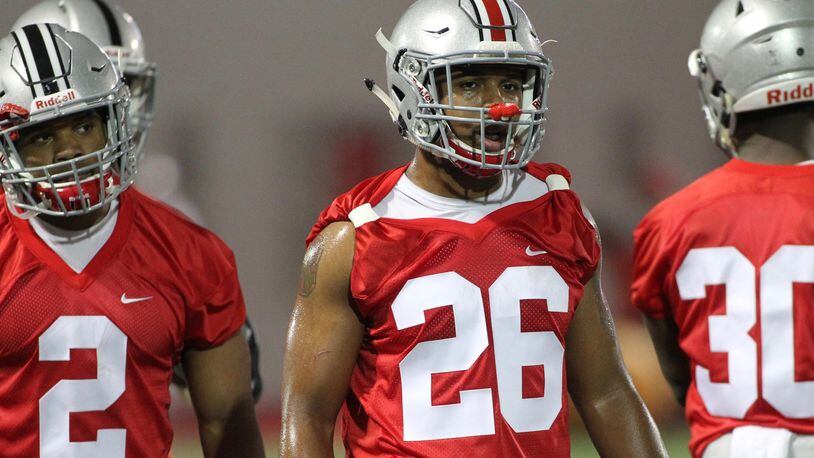Related to that, we’ve wondered about new quarterbacks coach Ryan Day’s impact on quarterback J.T. Barrett, and of course there are the recurring questions about a receiving room that has a harder time making consistent contributions on the field than sending players to the NFL.
RELATED: Ohio State needs offensive culture change to be more than idle chatter
But let’s be real: Ohio State is a running team.
That’s not only true during the Urban Meyer era but realistically every other one since, oh, about 1890.
Meyer was aware of this when he was hired, and he and his assistants spent a lot of time making sure nobody got the impression he would be turning his back on Woody Hayes’ most cherished tradition: Grinding opponents into dust with the ground game.
The Buckeyes went out and backed that up, too, producing a killer running game in each of Meyer’s first five seasons.
Braxton Miller got the ball rolling, and Carlos Hyde and Ezekiel Elliott took the baton from him.
Ohio State was still great at running the ball last season, but there was something missing: The big play.
RELATED: Miamisburg’s Myers part of developing OL at Ohio State
If the running game had produced more explosive gains, the passing problems might never have caught up with the 2016 Buckeyes.
As an example of how close — yet so far — they were, consider just one long run by Curtis Samuel was nearly enough to avoid disaster at Penn State.
But the fact remains those lightning bolts were too few and far between — and Samuel isn’t around anymore.
Sports Today: It’s a Cincinnati @Bengals game day! #WhoDey https://t.co/9OerF0EaEs pic.twitter.com/odCRk0vUk7
— daytonsports (@daytonsports) August 11, 2017
On the surface, the Ohio State running game doesn’t seem like it will be much different than last season. In fact, it could be worse since its best option for some extra juice (Samuel) is gone.
Barrett is back at quarterback, and Mike Weber is back as the No. 1 guy who will line up next to him.
They are both productive runners, but neither is the type of big-play threat Miller, Hyde or Elliott (or Samuel, a receiver who dabbled at running back). Barrett used to be, but he hasn’t shown the same explosiveness as a runner since breaking an ankle as a freshman in 2014.
So does that mean Ohio State is doomed to another year of needing to manufacture big plays beyond getting them from the backfield?
Maybe not.
With Weber nursing an injury, Meyer gave high marks to not one but three of his potential replacements: Antonio Williams, J.K. Dobbins and Demario McCall.
The development of Williams, who played sparingly behind then-redshirt freshman Weber and classmate McCall as a true freshman last season, and emergence of Dobbins could be huge for a couple of reasons.
McCall was impressive in limited opportunities last season, and Dobbins looked a lot like a bigger version of him in the spring.
Keeping Weber fresh is bound to help his explosiveness, but having confidence in those three also should let the coaching staff give McCall more opportunities in the role Samuel played most of the time last season: H.
So while the passing game may indeed improve, the running game could also be better with more options than the two most obvious.
About the Author
